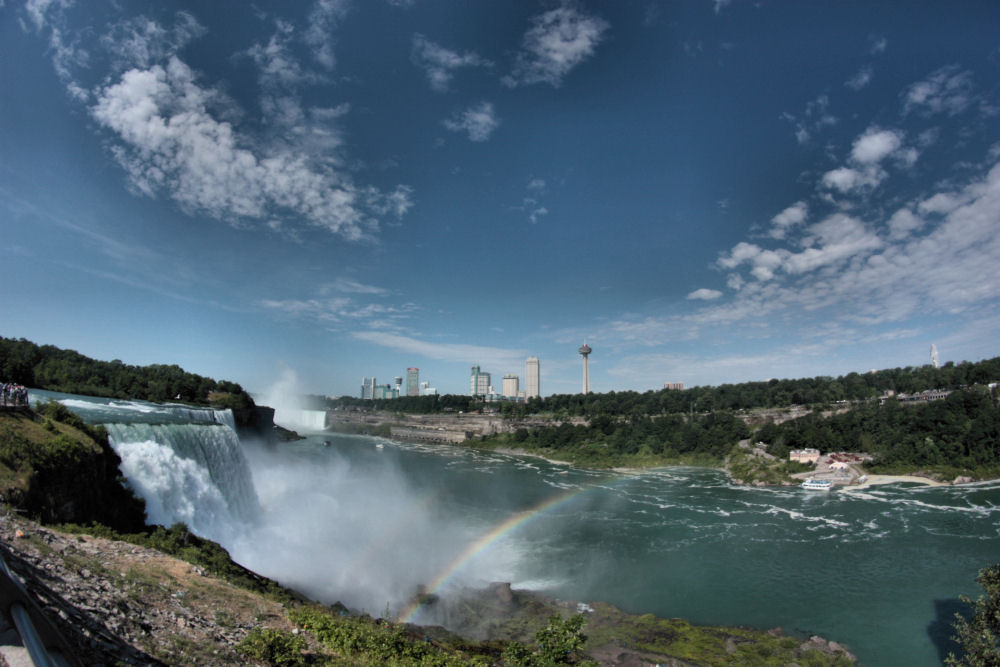
Niagara Falls
After stealthily blending in with the masses of Manhattan Island for five weeks, my inner-backpacker told me it was time for an out-of-city adventure. I contemplated Montauk and Green Mountain, pondering over maps and lack-luster tourist guide books, until I finally decided on what was both an obvious and predictable location; Niagara Falls. My reasoning was, despite the ten-hour train journey (a distance most Brits would treat like a round-the-world trip, packing enough food and water for a month) I was near enough to say I was in the “same part of the world” and therefore I should make the visit.
Staying in a hostel on the New York side of the border (just to enhance my hopes of becoming an explorer for the week), I quickly became acquainted with the town — its weathered exterior and seemingly restless inhabitants almost as intriguing as the falls themselves. In just under a mile, the bustling tourist destination dubbed the ‘Honeymoon Capital’ of the 1950s; hastily transforms from a deluge of 100 ft. cascading waterfalls, cliffside restaurants and bouncing tourists into a sea of derelict shopfronts and shy residents peering from the windows of tired houses, seeking out any sign of disturbance. Niagara’s 1950s population of roughly 100,000 has since halved, with whole families moving on to different towns and states due to the worsening employment conditions.
Consequently, the few locals that I did meet were working around Niagara Falls Gorge, entertaining tourists with boat tours and guided walks, and serving up a coolly polite “Enjoy your visit” to every photo-snapping swarm. Noticeably, also, was that although sharing one of the world’s biggest natural landmarks with an entirely different nation, both towns of Niagara Falls, Ontario and New York are more than willing to mock each other, culturally and linguistically.
Despite separation by a mere short stretch of water, accents, etiquette and official languages of the two cities are poles apart; I realized this on passing a souvenir shop five minutes within the Canadian border, with a t-shirt reading “I speak two languages, not just one. I live in a house, not an igloo. I eat meals not just maple syrup. I am Canadian.” proudly hanging by the door.
Right from the borderline there was an overwhelming sense of a cultural divide, experiencing both sides of gorge flippantly throwing about the casual “us” and “them” when referring to the other. Neatly displaying every road sign, tourist information board, and site map in both English and French, Niagara Falls, Ontario made for the more linguistically stimulating experience, — particularly for me — an outsider.
Bilingualism aside, eating breakfast in the U.S. and dinner in Canada couldn’t have been more different. A hand-on-hip “More coffee honey?” became a sprightly “Will that be all, Miss?” teamed with a side of sharp eye contact and a sprinkling of urgency. In essence, this reflected two things: the reserved, business-oriented atmosphere and the reminder that visitors are what keeps this town ticking. The falls themselves are also treated with similar possessive pronouns; “ours” and “theirs” to refer to the American and Horseshoe falls on each appropriate side, attaching verbal ownership to the already existing geographical.
Just like other natural phenomena in the world, Niagara Falls has shaped the towns around it, not just physically, but in giving its inhabitants a sense of pride. In this instance, a unique piece of geography becomes two, each receiving a different cultural family and therefore a different cultural history – and having roots in neither made my visit an ever more thrilling experience.
Athina Kontos is writer/photographer from the UK spending the summer in New York







